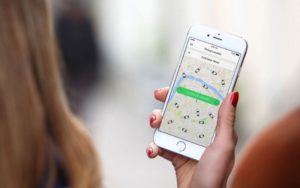Entertainment Venues: Let’s Make a Plan for Ride-Hailing Services
 When I write about customer experience, it’s typically from a digital and social media perspective, but I’m going in a slightly different direction today. While the following isn’t directly related to social media, it addresses aspects of the digital and in-person guest experience (and, truthfully, has the potential to create a social media kerfuffle).
When I write about customer experience, it’s typically from a digital and social media perspective, but I’m going in a slightly different direction today. While the following isn’t directly related to social media, it addresses aspects of the digital and in-person guest experience (and, truthfully, has the potential to create a social media kerfuffle).
The Issue
I recently traveled to Dallas, Texas for a Foo Fighters concert. The show was epic and the night was almost perfect, but for one issue. The experience was seamless once we arrived at the venue, but there was a wrinkle both before and after the show – especially after.
There appeared to be no plan on the part of the venue for ride-hailing services, such as Uber and Lyft. If a plan exists, it wasn’t sufficiently communicated to staff, guests, or drivers.
There are dozens of touchpoints in the customer experience journey and this is a seemingly small one in the grand scheme of things. But there are greater implications than the inconvenience of guests walking a few blocks to find their ride. As a single woman who often attends events with other women, a number of personal safety issues come to mind. That’s especially true when in an unfamiliar city. There are also traffic safety concerns as drivers often park in the right lane of traffic while waiting for riders.
I’ll provide six recommendations at the end of this article.
First, allow me to share my experience…
The Experience
We took an Uber to the show and Lyft for the ride back to our hotel (because I couldn’t get a WiFi connection with Uber). Long story short, no one knew where or how drop-offs and pick-ups were to take place. Not our drivers, not the police officers directing traffic, nor venue staff. Full disclosure: We didn’t ask everyone, but the people we did ask didn’t know.
As we arrived at the venue, our Uber driver pulled up to an officer and asked where he should drop us off. The officer directed him to Lot 10. As we pulled up to the gate at Lot 10, another officer told him to go back to Lot 8. Our driver then dropped us off on the street near the gate to Lot 8. A minor wrinkle. No big deal. In case you’re wondering, the first officer was correct. We should’ve been taken to Lot 10, according to the Uber and Lyft driver instructions (links below).
On our way out after the show, I asked two employees if there was an Uber/Lyft lot. They didn’t know. We walked back toward the gate where we’d been dropped off, believing that there may be drivers waiting or someone who could direct us to the appropriate place. As we walked I tried to connect with Uber, but couldn’t get through. I tried several times without success (I was unaware that I’d already lost access to the venue’s WiFi).
When we got to the street, I asked an officer if he could direct us, but he also had no answer. I never was able connect to Uber and heard others standing nearby complaining that they couldn’t connect either. I realized then that I should’ve tried to connect while I was nearer to the facility, but it was too late for that.
I managed to connect with Lyft and a driver was close by. Yea! A minute later, the driver called to say he couldn’t get to us because of traffic (he could’ve) and asked if we’d walk to meet him where he was pulled over on the side of the street. Neither my friend nor I were familiar with the area, making it difficult for him to explain to me where he was waiting. Once we established his location, we had to walk a few blocks to get to him.
This is where my personal safety concerns come into play. It isn’t that we minded walking a few blocks to connect with him, nor did we feel unsafe, but it can be dangerous for two women walking at night even with many other people in the area. This wouldn’t have been necessary (and shouldn’t have been) if the venue and ride service(s) had well-communicated plans in place.
I’ve since learned that both Uber and Lyft have instructions for their drivers listed on their sites regarding the Dallas venue, but they obviously need to do a better job of communicating that to drivers. Neither of our drivers were aware that there is a designated lot for them. (Dallas: Uber Driver Instructions | Lyft Driver Instructions)
As indicated in the driver instructions linked above, someone from the facility has communicated with Uber and Lyft about the existence of a designated lot, yet venue staff, officers, and their own drivers were unaware.
The problem isn’t specific to this venue, to be sure. I’ve had similar experiences almost every time I’ve used ride services after shows, at venues large and small, in multiple cities. It is something that should be addressed industry-wide as demand for these services continues to rise.
I’ve looked at a small sampling of venue websites from across the country and very few of them have any information regarding ride-hailing services. Some mention taxi, limo, and bus pick-up/drop-off locations without including ride-hailing services. Are they to go to the same location? It isn’t clear.
In thinking about what hadn’t worked well during my experience(s), I realized there are some simple, easily implemented solutions.
The Solutions
- Designate a lot or specific area for ride-hailing service drop-offs and pick-ups.
- Ensure WiFi access at or near the location. Even if drivers are in the lot, guests must still “request” a ride through the app(s).
- Communicate the location to all staff, including law enforcement. Every staff member should be able to answer this question. It’s extremely important that everyone working traffic knows the location so that they allow drivers access.
- Share the designated location with local ride-hailing companies. Some venues have partnered with local entities to offer a discount on the guest’s first ride to the venue.
- Display the location, including directions, on the venue’s website (and app, if applicable). Make it easy for guests and drivers to know where to go.
- Signage! A few free-standing sandwich signs at exits directing guests to the designated area would be incredibly helpful. Free-standing signage can be easily installed/removed (or repositioned should the designated area change). Placing the signs close to the exits would also serve as a reminder to guests to connect with the ride service app(s) before losing WiFi access as they move beyond the venue. See also number 1: Ensure WiFi access at or near the designated location.
These are small changes that will create a safer, more seamless experience for everyone, especially guests.
Whether you’re on the facility or guest side of the equation, I’d love to hear your thoughts (or concerns) regarding my proposed solutions. Please let me know what you think!


